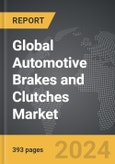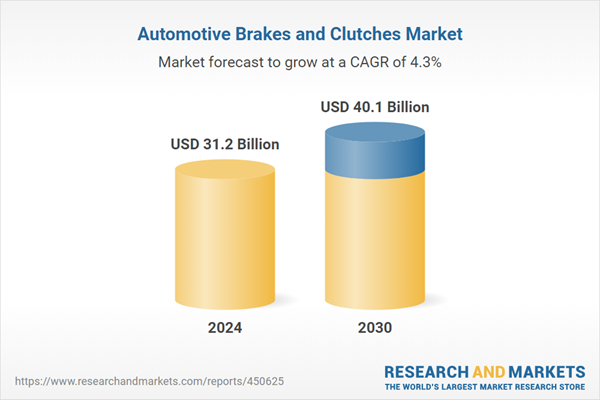The global market for Automotive Brakes and Clutches was valued at US$31.2 Billion in 2024 and is projected to reach US$40.1 Billion by 2030, growing at a CAGR of 4.3% from 2024 to 2030. This comprehensive report provides an in-depth analysis of market trends, drivers, and forecasts, helping you make informed business decisions. The report includes the most recent global tariff developments and how they impact the Automotive Brakes and Clutches market.
The growth in the automotive brakes and clutches market is driven by several factors. Technological advancements, such as the integration of advanced driver-assistance systems (ADAS) and autonomous driving technologies, have increased the demand for sophisticated braking systems capable of precise control and rapid response. The rise of electric and hybrid vehicles has also spurred innovation in regenerative braking systems, as manufacturers seek to maximize energy efficiency and range. Additionally, increasing consumer awareness of safety and regulatory mandates for safer vehicles have pushed manufacturers to incorporate advanced braking technologies, such as ABS and ESC, as standard features. Urbanization and the expanding middle class in emerging markets have led to a surge in vehicle ownership, further driving demand. Finally, the trend towards lightweight vehicles for improved fuel efficiency has necessitated the development of advanced materials for brakes and clutches, balancing performance with weight reduction. These factors collectively underscore the dynamic and evolving nature of the automotive brakes and clutches market.
The development of automotive brakes and clutches has been marked by continuous innovation aimed at improving performance, durability, and user experience. Anti-lock braking systems (ABS) and electronic stability control (ESC) have become standard features, enhancing safety by preventing wheel lock-up and maintaining vehicle control during emergencies. In the realm of clutches, the advent of automated manual transmissions (AMTs) and continuously variable transmissions (CVTs) has reduced the reliance on traditional clutch systems, integrating automated clutches for seamless operation. Furthermore, advancements in materials science have introduced ceramics and carbon composites in high-performance and racing applications, providing superior heat resistance and longevity compared to conventional materials. These innovations have not only enhanced the functionality of brakes and clutches but also contributed to the overall efficiency and safety of modern vehicles.
Segments: Distribution Channel (OEM, Aftermarket); End-Use (Passenger Cars, Commercial Vehicles).
Geographic Regions/Countries: World; USA; Canada; Japan; China; Europe; France; Germany; Italy; UK; Spain; Russia; Rest of Europe; Asia-Pacific; Australia; India; South Korea; Rest of Asia-Pacific; Latin America; Argentina; Brazil; Mexico; Rest of Latin America; Middle East; Iran; Israel; Saudi Arabia; UAE; Rest of Middle East; Africa.
The analysts continuously track trade developments worldwide, drawing insights from leading global economists and over 200 industry and policy institutions, including think tanks, trade organizations, and national economic advisory bodies. This intelligence is integrated into forecasting models to provide timely, data-driven analysis of emerging risks and opportunities.
Global Automotive Brakes and Clutches Market - Key Trends & Drivers Summarized
Automotive brakes and clutches are critical components in vehicle systems, playing essential roles in safety and performance. Brakes are responsible for decelerating or stopping the vehicle by converting kinetic energy into thermal energy through friction. There are various types of braking systems, including disc brakes, drum brakes, and regenerative brakes. Disc brakes are widely used due to their efficiency and cooling capabilities, while drum brakes are commonly found in older or more budget-friendly models. Regenerative braking, primarily utilized in electric and hybrid vehicles, recaptures energy during braking to enhance efficiency. Clutches, on the other hand, connect and disconnect the engine from the transmission, allowing for smooth gear changes. They are vital in manual transmission vehicles, providing control over the engagement and disengagement of power. Modern vehicles often use single-plate dry clutches, but advancements have led to dual-clutch systems offering faster shifts and improved fuel efficiency.The growth in the automotive brakes and clutches market is driven by several factors. Technological advancements, such as the integration of advanced driver-assistance systems (ADAS) and autonomous driving technologies, have increased the demand for sophisticated braking systems capable of precise control and rapid response. The rise of electric and hybrid vehicles has also spurred innovation in regenerative braking systems, as manufacturers seek to maximize energy efficiency and range. Additionally, increasing consumer awareness of safety and regulatory mandates for safer vehicles have pushed manufacturers to incorporate advanced braking technologies, such as ABS and ESC, as standard features. Urbanization and the expanding middle class in emerging markets have led to a surge in vehicle ownership, further driving demand. Finally, the trend towards lightweight vehicles for improved fuel efficiency has necessitated the development of advanced materials for brakes and clutches, balancing performance with weight reduction. These factors collectively underscore the dynamic and evolving nature of the automotive brakes and clutches market.
The development of automotive brakes and clutches has been marked by continuous innovation aimed at improving performance, durability, and user experience. Anti-lock braking systems (ABS) and electronic stability control (ESC) have become standard features, enhancing safety by preventing wheel lock-up and maintaining vehicle control during emergencies. In the realm of clutches, the advent of automated manual transmissions (AMTs) and continuously variable transmissions (CVTs) has reduced the reliance on traditional clutch systems, integrating automated clutches for seamless operation. Furthermore, advancements in materials science have introduced ceramics and carbon composites in high-performance and racing applications, providing superior heat resistance and longevity compared to conventional materials. These innovations have not only enhanced the functionality of brakes and clutches but also contributed to the overall efficiency and safety of modern vehicles.
Report Scope
The report analyzes the Automotive Brakes and Clutches market, presented in terms of units. The analysis covers the key segments and geographic regions outlined below.Segments: Distribution Channel (OEM, Aftermarket); End-Use (Passenger Cars, Commercial Vehicles).
Geographic Regions/Countries: World; USA; Canada; Japan; China; Europe; France; Germany; Italy; UK; Spain; Russia; Rest of Europe; Asia-Pacific; Australia; India; South Korea; Rest of Asia-Pacific; Latin America; Argentina; Brazil; Mexico; Rest of Latin America; Middle East; Iran; Israel; Saudi Arabia; UAE; Rest of Middle East; Africa.
Key Insights:
- Market Growth: Understand the significant growth trajectory of the OEM segment, which is expected to reach US$25.6 Billion by 2030 with a CAGR of a 4.5%. The Aftermarket segment is also set to grow at 3.9% CAGR over the analysis period.
- Regional Analysis: Gain insights into the U.S. market, valued at $8.5 Billion in 2024, and China, forecasted to grow at an impressive 6.3% CAGR to reach $5.5 Billion by 2030. Discover growth trends in other key regions, including Japan, Canada, Germany, and the Asia-Pacific.
Why You Should Buy This Report:
- Detailed Market Analysis: Access a thorough analysis of the Global Automotive Brakes and Clutches Market, covering all major geographic regions and market segments.
- Competitive Insights: Get an overview of the competitive landscape, including the market presence of major players across different geographies.
- Future Trends and Drivers: Understand the key trends and drivers shaping the future of the Global Automotive Brakes and Clutches Market.
- Actionable Insights: Benefit from actionable insights that can help you identify new revenue opportunities and make strategic business decisions.
Key Questions Answered:
- How is the Global Automotive Brakes and Clutches Market expected to evolve by 2030?
- What are the main drivers and restraints affecting the market?
- Which market segments will grow the most over the forecast period?
- How will market shares for different regions and segments change by 2030?
- Who are the leading players in the market, and what are their prospects?
Report Features:
- Comprehensive Market Data: Independent analysis of annual sales and market forecasts in US$ Million from 2024 to 2030.
- In-Depth Regional Analysis: Detailed insights into key markets, including the U.S., China, Japan, Canada, Europe, Asia-Pacific, Latin America, Middle East, and Africa.
- Company Profiles: Coverage of players such as Advics Co. Ltd., Aisin Seiki Co. Ltd., Akebono Brake Industry Co. Ltd., Bendix Commercial Vehicle Systems, BorgWarner Inc. and more.
- Complimentary Updates: Receive free report updates for one year to keep you informed of the latest market developments.
Some of the 69 companies featured in this Automotive Brakes and Clutches market report include:
- Advics Co. Ltd.
- Aisin Seiki Co. Ltd.
- Akebono Brake Industry Co. Ltd.
- Bendix Commercial Vehicle Systems
- BorgWarner Inc.
- Brembo S.P.A
- Continental Automotive Systems (CAS)
- Dana Incorporated
- Exedy Corporation
- F.C.C. Co., Ltd.
- Knorr-Bremse AG
- Nisshinbo Brake Inc.
- Robert Bosch GmbH
- Schaeffler Technologies AG & Co. KG
- TRW Automotive
- Valeo SA
- ZF Japan Co. Ltd.
- ZF Sachs AG
Tariff Impact Analysis: Key Insights for 2025
Global tariff negotiations across 180+ countries are reshaping supply chains, costs, and competitiveness. This report reflects the latest developments as of April 2025 and incorporates forward-looking insights into the market outlook.The analysts continuously track trade developments worldwide, drawing insights from leading global economists and over 200 industry and policy institutions, including think tanks, trade organizations, and national economic advisory bodies. This intelligence is integrated into forecasting models to provide timely, data-driven analysis of emerging risks and opportunities.
What’s Included in This Edition:
- Tariff-adjusted market forecasts by region and segment
- Analysis of cost and supply chain implications by sourcing and trade exposure
- Strategic insights into geographic shifts
Buyers receive a free July 2025 update with:
- Finalized tariff impacts and new trade agreement effects
- Updated projections reflecting global sourcing and cost shifts
- Expanded country-specific coverage across the industry
Table of Contents
I. METHODOLOGYII. EXECUTIVE SUMMARY2. FOCUS ON SELECT PLAYERSIII. MARKET ANALYSISINDIASOUTH KOREAREST OF ASIA-PACIFICLATIN AMERICAARGENTINABRAZILMEXICOREST OF LATIN AMERICAMIDDLE EASTAFRICAIV. COMPETITION
1. MARKET OVERVIEW
3. MARKET TRENDS & DRIVERS
4. GLOBAL MARKET PERSPECTIVE
UNITED STATES
CANADA
JAPAN
CHINA
EUROPE
FRANCE
GERMANY
ITALY
UNITED KINGDOM
SPAIN
RUSSIA
REST OF EUROPE
ASIA-PACIFIC
Companies Mentioned (Partial List)
A selection of companies mentioned in this report includes, but is not limited to:
- Advics Co. Ltd.
- Aisin Seiki Co. Ltd.
- Akebono Brake Industry Co. Ltd.
- Bendix Commercial Vehicle Systems
- BorgWarner Inc.
- Brembo S.P.A
- Continental Automotive Systems (CAS)
- Dana Incorporated
- Exedy Corporation
- F.C.C. Co., Ltd.
- Knorr-Bremse AG
- Nisshinbo Brake Inc.
- Robert Bosch GmbH
- Schaeffler Technologies AG & Co. KG
- TRW Automotive
- Valeo SA
- ZF Japan Co. Ltd.
- ZF Sachs AG
Table Information
| Report Attribute | Details |
|---|---|
| No. of Pages | 393 |
| Published | April 2025 |
| Forecast Period | 2024 - 2030 |
| Estimated Market Value ( USD | $ 31.2 Billion |
| Forecasted Market Value ( USD | $ 40.1 Billion |
| Compound Annual Growth Rate | 4.3% |
| Regions Covered | Global |









